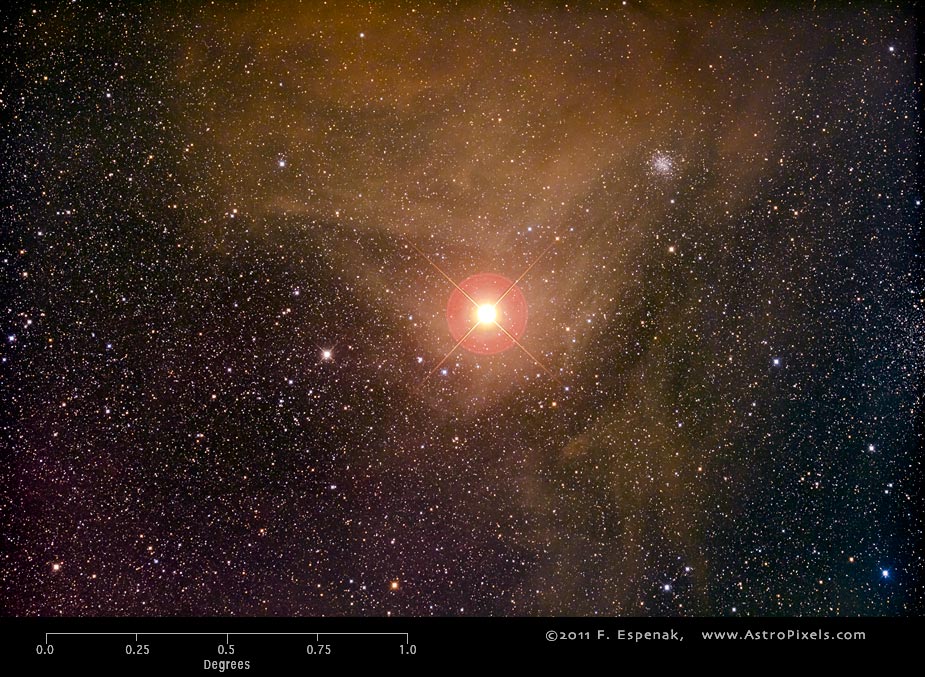Antares
Antares or Alpha Scorpii (Alp Sco) is the brightest naked eye star in the constellation Scorpius. With an apparent magnitude of 1.06v, Antares is the 16th brightest star in the entire sky (see: 50 Brightest Stars ). Its absolute magnitude is -5.28 and its distance is 604 light years.The Equinox J2000 equatorial coordinates are RA = 16h 29m 24.4s, Dec = -26° 25' 55".
Antares has a spectral type of M1Ib, a surface temperature of 3500° Kelvin and a luminosity 65,000 times the Sun. It has a mass of 15.5 solar masses and a diameter 800 times the Sun.
The image above shows the uncropped view of Antares (North is up) through the Takahashi E-180 Astrograph.
Antares is a supergiant star (spectral type M1.5Iab) with a mass 15 to 18 solar masses and a radius of approximately 883 times that of the Sun. If it were placed at the center of the Solar System, its outer surface would lie between the orbits of Mars and Jupiter. Based upon parallax measurements, Antares is approximately 550 light-years (170 parsecs) from Earth. Antares has a visual luminosity is about 10,000 times that of the Sun, but because the star radiates a considerable amount of energy in the infrared, the bolometric luminosity is 65,000 times that of the Sun. It is also is a slow irregular variable star (type LC), whose apparent magnitude varies from +0.88 to +1.16.
Antares is at opposition to the Sun around May 31 of each year, when the star is visible all night long. At this time, Antares rises at dusk and sets at dawn. For approximately two to three weeks on either side of November 30, Antares is not visible in the night sky, being lost in the Sun's glare. Along with Aldebaran, Spica, and Regulus it is one of the four brightest stars near the ecliptic and therefore can be occulted by the Moon and rarely by the planets.
Antares has a secondary companion star, Antares B, that changed from an angular separation of 3.3 arcseconds in 1854 to 2.86 arcseconds in 1990. The last is equal to a projected separation of about 529 Astronomical Units (AU) at the estimated distance of Antares, giving a minimum value for the separation of the pair. Spectroscopic examination of the energy states in the outflow of matter from the companion star suggest that it is about 224 AU behind the primary, giving a combined separation of about 574 AU. The stellar classification of this star is B2.5, with numerous spectral lines suggesting it has been polluted by matter ejected by Antares. At magnitude 5.5, it is only 1/370th as bright visually as Antares A, although it shines with 170 times the Sun's luminosity.
It is normally difficult to see in small telescopes due to Antares' glare, but can sometimes be seen in apertures over 150 mm (5.9 in). The companion is often described as green, but this probably a contrast effect. Antares B can be observed with a small telescope for a few seconds during lunar occultations while Antares itself is hidden by the Moon; it was discovered by Johann Tobias Bürg during one such occultation in 1819.The orbit is poorly known, with an estimated period of 878 years.
The description above is based on the Antares entry in Wikipedia.For more information about Antares, see Stars (Jim Kaler).
Technical Details
- Object: Antares
- Other Names: Alpha Scorpii, HR6134, HD148478, HIP80763
- Object Type: bright star
- Object Data: Apparent Magnitude = 1.06v, Absolute Magnitude = -5.28, distance = 604 light years
- Object Position (Equinox J2000): RA = 16h 29m 24.4s, Dec = -26° 25' 55", Constellation = Scorpius
- Date/Time: 2011 Apr 11 at 09:37:53 UTC
- Location: Bifrost Astronomical Observatory, Portal, AZ
- Mount: Astro-Physics 1200GTO
- Telescope: Takahashi Epsilon 180 Hyperbolic Astrograph
- Camera: Canon EOS 550D (Rebel T2i) (modified with a Baader UV/IR filter)
- Field of View: 1.70° x 2.56° at 1.7 arc-sec/pixel (web version: 10.0 arc-sec/pixel)
- Exposure: 2 x 300s, f/2.8, ISO 800
- File Name: Antares-01w.jpg
- Processing (Adobe Camera Raw): Graduated Filter, Vignetting Correction, Noise Reduction, White Balance, Curves
- Processing (Photoshop CS5): Average Images, Curves, Noise Reduction
- Original Image Size: 3454 × 5179 pixels (17.9 MP); 11.5" x 17.3" @ 300 dpi
- Rights: Copyright 2011 by Fred Espenak. All Rights Reserved. See: Image Licensing.
